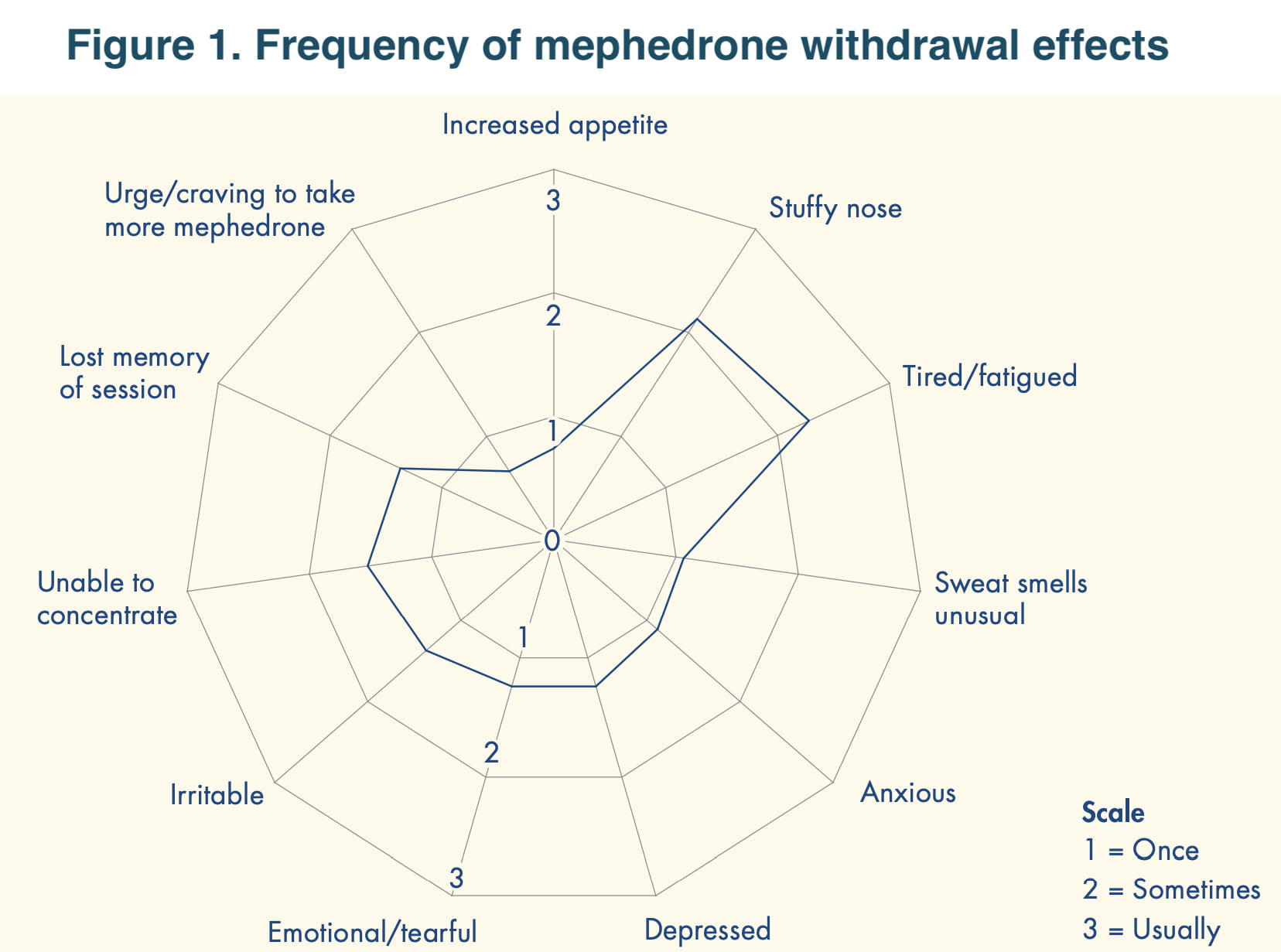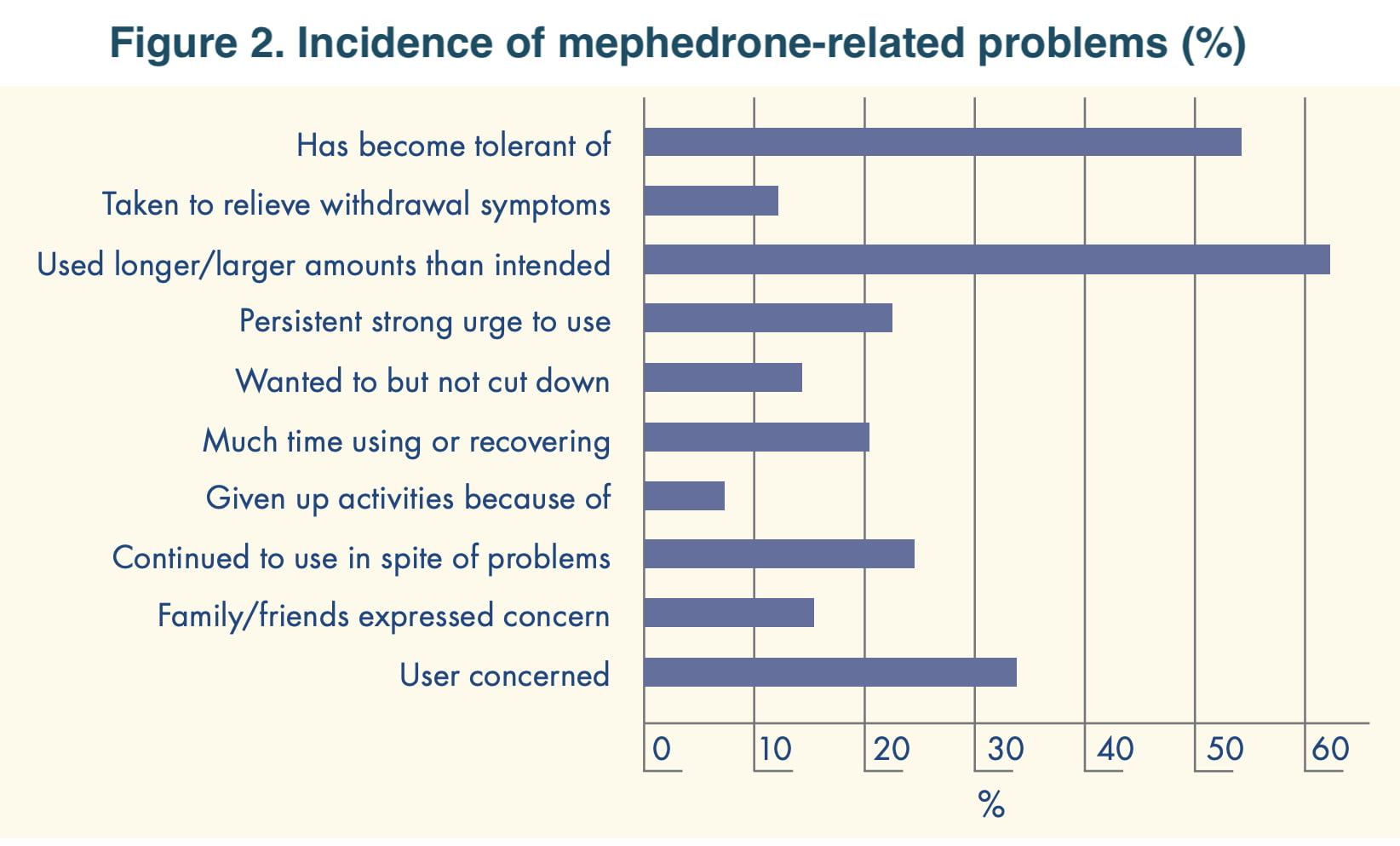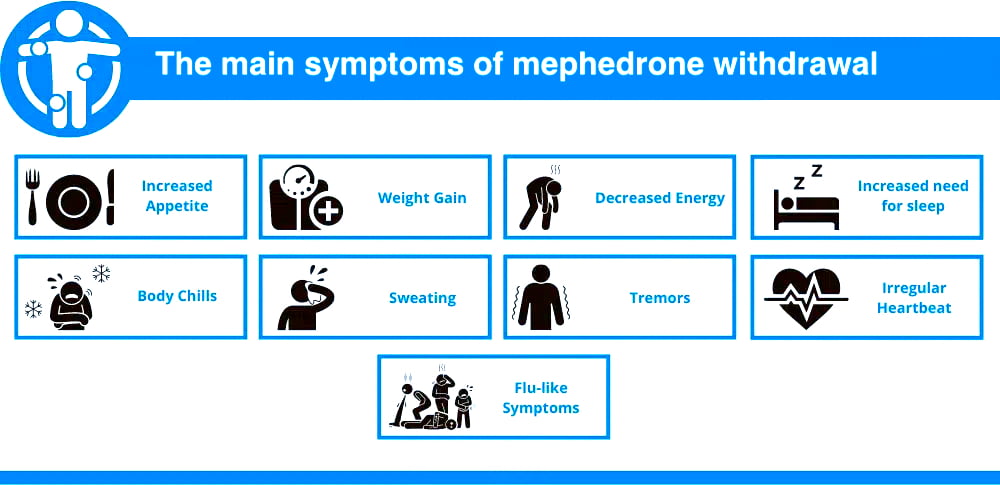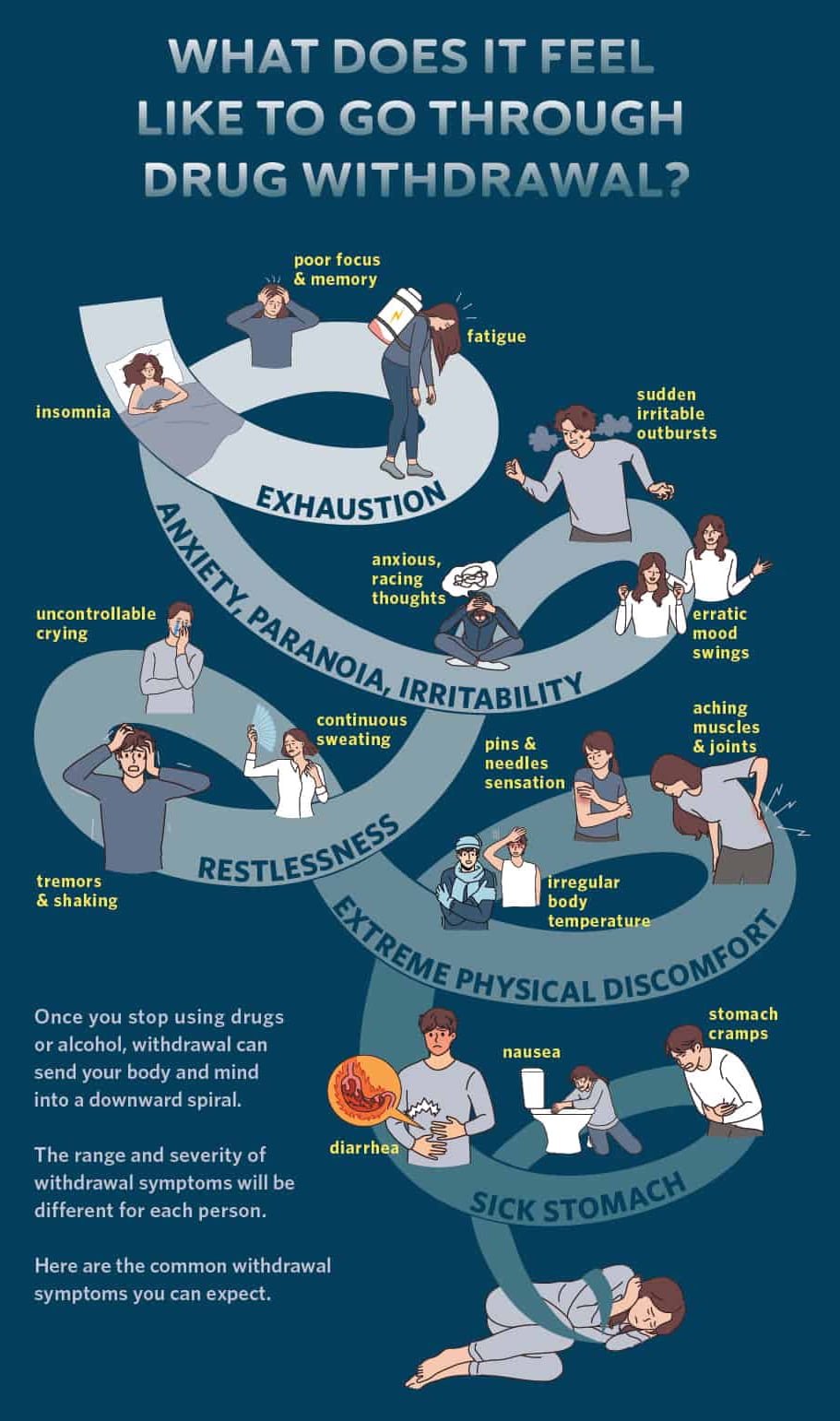What does mephedrone do? What is safe mephedrone withdrawal? Much of what is known about the adverse side effects of mephedrone is derived from anecdotal reports. Users warn of a feeling of intense paranoia and a prolonged withdrawal from the drug that lasts as long as nine hours. Some say withdrawal from mephedrone is worse than from cocaine.
The drug’s effects on the brain are no less dangerous, although much remains unknown about how it affects the central nervous system (CNS) and the blood-brain barrier. Recent studies show that mephedrone damages the blood-brain barrier due to several factors: disruption of the blood-brain barrier, inflammation, and endothelial activation. In the history of mephedrone, there are many reports of psychotic, aggressive behavior due to mephedrone use.
Other negative mental and psychological side effects of mephedrone use include:
- Euphoria quickly turning into paranoia
- Uncontrollable cravings for mephedrone
- Depression
- Nightmares
- Extreme agitation
- Inability to sleep (insomnia)
- Hallucinations and delusions
- Episodes of self-harm
- Suicidal thoughts or suicide attempts
The mechanism of action of mephedrone is due to blockade of reuptake of the monoamine neurotransmitters serotonin, dopamine and noradrenaline, and inhibition of monoamine oxidase and catechol-O-methyltransferase, which increases the content of the above neurotransmitters in the synaptic gap. Mephedrone is also a monoamine-releasing agent.
The increased long-term concentration of monoamines in the synaptic cleft underlies the stimulant, euphoric, and hallucinatory effects of mephedrone, as well as acute and chronic dopaminergic and serotonergic disorders. Interestingly, mephedrone has a greater affinity for dopamine transport than serotonin.
Synthetic cathinones can selectively and sustainably reduce VMAT2 function within the serotonin system, promoting the formation of unchanged forms of serotonin, which in turn affect the formation of active oxygen compounds, leading to neuronal stimulation, selective serotonin neurotoxicity.
Mephedrone elicits a dose-dependent elevation of extracellular dopamine and 5-HT content in nucleus accumbens (NAcc), ventral tegmental area (VTA), striatum, substantia nigra and frontal cortex. Despite mephedrone’s greater action in vitro as a substrate and blocker at DAT relative to SERT, these in vivo data indicate preferential elevation in all areas of 5-HT relative to dopamine.
The rapidity of these increases is largely contingent on mephedrone’s route of administration, with increases observed following intravenous and subcutaneous injection (within 15 to 20 minutes) than by intraperitoneal (within 30 minutes). Irrespective of administration route, dopamine and 5-HT levels generally peak around 40 min post-administration of mephedrone, before returning to basal levels within one hour. Also, studies have shown that mephedrone induces excessive secretion of VEGF-A and PDGF-BB in the hBMVEC.
Thus, mephedrone-induced damage to the blood-brain barrier includes the following changes: conversion of the tight contact protein complex, leakage or hyperpermeability of the barrier, vascular endothelial activation, and proliferative inflammation.
Considering that lethal outcomes in acute mephedrone intoxication are often caused by vasogenic cerebral edema, we can conclude that the neuroinflammatory process is a consequence of dysfunction of cerebral endothelial cells. In addition, in the presence of concomitant diseases (e.g., HIV), the use of mephedrone may promote the migration of HIV-infected immune cells across the blood-brain barrier into the brain parenchyma.
What Is Drug Withdrawal?
Withdrawal syndrome – is the unwanted and unpleasant symptoms and signs that occur after you stop abusing an addictive substance. Withdrawal from addictive substances can occur as a result of a personal decision or in a clinically supervised setting. There is a difference between people in the appearance of signs and symptoms of withdrawal.
Needless to say, it is much easier to get rid of substance abuse without WS. In the absence of WS, the development of a dangerous addiction, which manifests as compulsive drug seeking and use behavior, will be difficult. From this point of view, treating these signs and symptoms will reduce the relapse of drug abuse. WS is the appearance of unpleasant symptoms, well described in animal models and humans.
The emergence of withdrawal symptoms during the withdrawal period will lead to increased relapses in drug abuse. Therefore, it would be reasonable to think that in order to control addiction, it is necessary to suppress unwanted symptoms and signs. CB has been described as two-component: affective and somatic. Both cause relapse of addiction.
Affective symptoms include dysphoria, irritability, and anxiety, which can contribute to aversively motivated drug seeking, and somatic symptoms, especially in animal models, include diarrhea, facial fasciences/teeth tapping, paw tremors, head shaking, swallowing, salivation, chromodacryorrhea, ptosis, abnormal posture, erection/ejaculation/genital care, and irritability.
Drug withdrawal symptoms are easy to diagnose, the symptoms will disappear or diminish with more of the drug. They occur if a person misses a dose or tries to stop taking a drug when there is physical dependence.
Any drug that changes a person’s physical or mental well-being can lead to addiction. This includes drugs such as cocaine, alcohol, opiates, amphetamines, prescription drugs that are addictive, and over-the-counter drugs that contain codeine. When a person develops a drug addiction, their body and brain undergo a series of radical physiological and chemical changes that cause them to become tolerant to the effects of the drug. The body and brain do this automatically with the addictive drug so that the person can continue to function.
A person with a predisposition to abuse drugs will want to feel the effects of the drug that initially gave them a powerful euphoric high. This leads them to take more of the drug. The vicious cycle of tolerance and taking ever-increasing doses of the drug never ends. Unless medical and therapeutic intervention is used to break the cycle of addiction, the addicted person will suffer increasingly serious consequences to their physical, psychological, emotional, social and occupational health.
Symptoms of Mephedrone Withdrawal
All withdrawal symptoms are always dangerous for the person, regardless of the type of drug or the length of time it has been used. Withdrawal is usually characterized by an inadequate state accompanied by increased aggression and uncontrollable bouts of rage. After withdrawal from mephedrone, severe withdrawal syndrome may result in delinquency and even suicidal impulses, as the addict is willing to do anything to relieve his suffering.
According to some researchers, intranasal use of mephedrone has addictive potential comparable to cocaine and methamphetamine use. In a survey of 1,500 mephedrone users, 50% of respondents reported feeling dependent on the drug. Another study found 25 percent of users reported cravings for mephedrone. The main symptoms of a major addiction syndrome as a result of mephedrone use have been described in many works: loss of situational and quantitative control, craving for the substance, and increased tolerance. Irresistible craving for the drug causes aggressive behavior, anxiety, depression, and mental disorders.
The main manifestations of withdrawal syndrome are as follows: increased fatigue, insomnia, impaired concentration, emotional hyperesthesia, nasal congestion, intense tremor, chills, temperature increase to feverish levels or its decrease below physiological parameters, tachycardia, headache with migraine-like sensations, development of depressive symptoms with a strong adynamic component, anxiety, transient paranoid reactions. The withdrawal period of synthetic cathinones users is conditionally divided into two phases:
The acute phase: disorders of the affective spectrum, most often anxious depression, persistent insomnia, flashbacks, decreased appetite, restlessness, transient episodes of simple auditory hallucinations.
Subacute phase: affective disorders with an adynamic component, decreased appetite, motor retardation, shallow sleep with frequent awakenings.
In general, the withdrawal period when using cathinones lasts 15-25 days, depending on the particular substance, length of use, age of the patient, and accompanying somatic disorders.
Physical dependence on mephedrone lasts up to 12-13 days. During the first three days the former addict does not experience almost any discomfort, his domestic and professional activities do not undergo changes, deterioration of health does not occur. On average withdrawal withdrawal in its active phase appears on the fourth day after quitting the narcotic and works for up to two weeks. The former addict experiences unexplained anxiety, nervousness and irritability. At this stage, the substance completely leaves the body and a period of active psychological and physical craving for a new dose begins. This stage is characterized by the following physiological and mental changes in the body:
- Depressed mood;
- Increased heart palpitations;
- Soreness in the joints;
- Trembling in the extremities;
- Shortness of breath;
- Chills and fever;
- Increased sweating;
- Cramps;
- Signs of gastrointestinal distress.
Day 14-15 of withdrawal from mephedrone becomes the peak day in terms of craving for a new dose, which is accompanied by increased nausea, tremors and joint pains. The former addict faces a strong desire to take mephedrone again to relieve all the unpleasant symptoms. The condition is aggravated by fear and lack of understanding how the person will continue to live without the next dose. Mephedrone withdrawal treatment can begin as early as 15 days after the last act of mephedrone use. Specialists consider this period to be the most successful in convincing a mephedrone addict to seek professional help.
Conclusion
Addiction at the mental level is formed just as quickly. MCAT gives a feeling of omnipotence, intensifies and aggravates all the senses, in simple terms, the addict feels like a superhuman. When the effect ends, a strong depression sets in. It is natural that the addict wants to return old feelings and feel on top of the world again. Systematic use of mephedrone significantly strengthens psychological dependence. With each new dose a person stops enjoying the usual daily pleasures.
The only possible way to achieve euphoria is repeated compulsive use of mephedrone. Gradually MCAT leads to body exhaustion, mental retardation, development of various chronic diseases. That is why not only withdrawal from mephedrone is dangerous, but also those pathological changes in the body that it provokes. The mephedrone treatment process usually begins with medically assisted detoxification.
This phase of treatment involves helping users overcome their physical dependence on mephedrone. The intensity of withdrawal symptoms during detoxification varies from person to person, depending on how much mephedrone they have taken and how long they have taken it.The detoxification stage is usually followed by various forms of therapy. Individual therapy and other forms of therapy, such as cognitive behavioral therapy, help the recovering user identify the negative thinking patterns that may have led them to use drugs, as well as ways to avoid them. Group therapy offers people a sense of community with people with whom they can easily find common ground.





